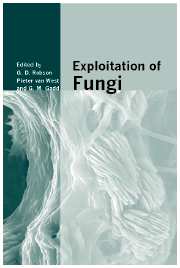Book contents
- Frontmatter
- Contents
- List of contributors
- Preface
- I Comparative and functional fungal genomics
- II Bioactive molecules
- III Protein folding and secretion
- 7 The role of microtubules and motors for polarized growth of filamentous fungi
- 8 The cellular response to protein unfolding stress
- 9 Protein secretion and associated stresses in Aspergillus: a genomic perspective
- IV Fungal bioremediation
- V Fungal biocontrol of pests
- Index
- References
9 - Protein secretion and associated stresses in Aspergillus: a genomic perspective
from III - Protein folding and secretion
Published online by Cambridge University Press: 05 October 2013
- Frontmatter
- Contents
- List of contributors
- Preface
- I Comparative and functional fungal genomics
- II Bioactive molecules
- III Protein folding and secretion
- 7 The role of microtubules and motors for polarized growth of filamentous fungi
- 8 The cellular response to protein unfolding stress
- 9 Protein secretion and associated stresses in Aspergillus: a genomic perspective
- IV Fungal bioremediation
- V Fungal biocontrol of pests
- Index
- References
Summary
Introduction
Aspergillus spp. are filamentous fungi of which several have been studied in relation to the secretion of proteins. This chapter will only discuss those species for which there is currently genome sequence information even though the secretion of proteins is probably an important aspect of the lifestyles of the more than 180 known species of Aspergillus. Therefore, the emphasis is with a common saprophyte and human pathogen (Aspergillus fumigatus), a sexual species and one that has been developed as a convenient laboratory species for basic studies (Aspergillus nidulans), and two species that are widely exploited commercially for their secreted enzymes (Aspergillus niger and Aspergillus oryzae). The genome sequence data have been recently acquired and made available to the scientific community so it is particularly timely that the annotated sequences serve as a framework for this chapter on protein secretion. That will also avoid a substantial amount of repetition because there are several excellent reviews on protein secretion by Aspergillus that are primarily pre-genomic in their outlook (Conesa et al., 2001; Punt et al., 2002; MacKenzie et al., 2004) even though extensive use of gene sequences and expression data has been made in the reviewed literature. More recent reviews have been able to take a more genomic view from the outset (Archer & Dyer, 2004; Archer & Turner, 2005) but, even then, the full annotated genome sequences were not available.
- Type
- Chapter
- Information
- Exploitation of Fungi , pp. 140 - 158Publisher: Cambridge University PressPrint publication year: 2007



